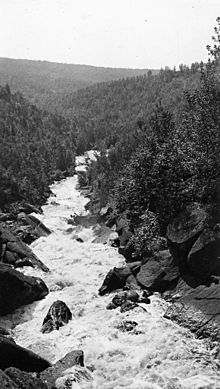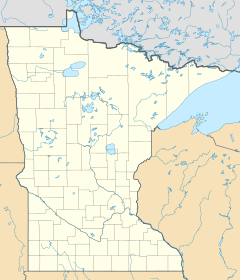Poplar River (Lake Superior) facts for kids
Quick facts for kids Poplar River |
|
|---|---|

Upper Poplar River Falls
|
|
|
Mouth of the Poplar River
|
|
| Native name | Ga-manazadika Zibi |
| Country | United States |
| State | Minnesota |
| County | Cook County |
| Physical characteristics | |
| Main source | Sawbill Camp, Gust Lake 47°48′26″N 90°45′39″W / 47.8071156°N 90.7609616°W |
| River mouth | Lutsen, Lake Superior 47°38′09″N 90°42′26″W / 47.6357311°N 90.7073611°W |
| Length | 21.7 miles (34.9 km) |
| Basin features | |
| Basin size | 114 square miles (300 km2) |
The Poplar River is a river in northeastern Minnesota. It flows into Lake Superior.
Contents
What's in a Name?
The Poplar River got its English name from its original Ojibwe name. The Ojibwe people called it Ga-manazadika Zibi. This means "place-of-poplars river." The specific type of poplar tree is called the Balm-of-Gilead.
River Journey and Landscape
The Poplar River is about 21.7 miles (34.9 km) long. It starts in Gust Lake. Then it flows into Lake Superior near Lutsen.
River Branches
The Poplar River has several smaller streams that flow into it. These are called tributaries. The main ones are Mistletoe Creek, the Tait River, Caribou Creek, and Barker Creek.
River's Path
The river drains an area of 114 square miles (300 km2). Most of this area is on a high, flat land called the Superior Upland plateau. At the start, the river's slope is gentle. It gets much steeper as it gets closer to Lake Superior.
Waterfalls and Rapids
About three miles from where it meets Lake Superior, the Poplar River flows over a series of waterfalls. The last 2.2 miles (3.5 km) of the river are very exciting! They have rapids that range from easy (Class II) to very difficult (Class IV+ or V).
Past River Changes
In the past, people built dams on the Poplar River. These dams helped power the nearby town of Lutsen. It was the only hydropower plant on a North Shore river.
River's Surroundings
Most of the land around the Poplar River is covered by forests (77%). About 19% is wetland. The rest is made up of grasslands, open water, farms, or bare rock. There are 132 miles (212 km) of streams in the Poplar River area. There are also 87.6 miles (141.0 km) of roads.
Amazing River Animals
The lower part of the Poplar River is a great place for fishing. You can find different types of salmon here. These include pink, chinook, and coho salmon in the spring. In the fall, you might catch rainbow and brook trout.
Record-Breaking Fish
The biggest chinook salmon ever caught in Minnesota was found here in 1989! It was a truly huge fish.
Fish Barriers
A waterfall about 400 feet (120 m) from the river's mouth stops fish from Lake Superior from swimming further upstream. This helps keep different fish populations separate.
Trout in the River
You can find brook trout in the upper 17 miles of the Poplar River. The further north you go, the more trout you'll see. In the lower parts, it's harder for brook trout to lay their eggs. This is because of too much silt and warm water in the summer.
Other Fish Species
Other fish like smallmouth bass, pumpkinseed sunfish, and bluegill are becoming more common in the lower river. Smallmouth bass have spread into almost every major lake north of Rice Lake. This happened after they were first put into Crescent Lake in the 1990s.
Logging History
In the late 1800s and early 1900s, logging was a big business in northern Minnesota. The Poplar River was used to float logs from the forests to Lake Superior. However, the river's shape made it difficult to move logs.
Lutsen Tie & Post Company
A company called Lutsen Tie & Post Company had a sawmill upstream on the Poplar River. They even built a short railroad for a few years to move wood. But this railroad was soon abandoned.
Logging Today
Some logging still happens today, mostly on private land. However, the Poplar River area has less logging activity compared to other nearby rivers.
Protecting the Poplar River
The United States Forest Service helps manage the land around the Poplar River. They have a simple campground there. These campgrounds are free to use. They don't have drinking water or trash cans, so campers need to be prepared. The Poplar River Rustic Campground has four spots for tents. Two of these spots are long enough for RVs.


